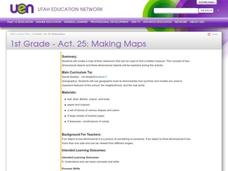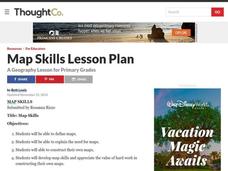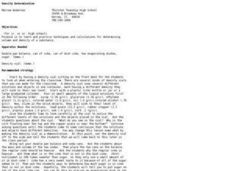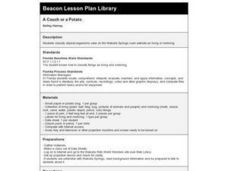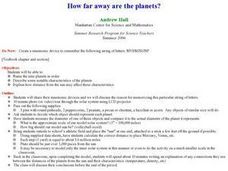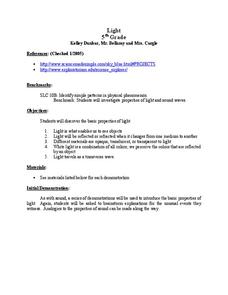Curated OER
The Transformer
Fourth graders practice measuring different objects in inches. Individually, they estimate the length of the same object in centimeters and then calculate the actual length. They compare and contrast their estimate to the actual length...
Curated OER
Clean Sweep
Students organize and conduct a cleanup of a local beach, lake, or stream. They keep track of the types and amounts picked up and analyze this information in the classroom.
Curated OER
Bus Graph
Students make predictions about which bus takes the most/least students in the classroom. They use KidPix bus stamp for each student who goes home on that bus number and record data and discuss predictions.
Curated OER
Making Maps
First graders create a map of their classroom that can be used to find a hidden treasure. They examine two- and three-dimensional objects and discover characteristics.
Curated OER
Map Skills
Students explore geography by creating a poster presentation in class. In this mapping lesson, students identify the different components featured on a modern day map and how to utilize them in order to navigate. Students read a book...
Curated OER
Is a Pulley a Special Kind of Lever?
Fifth graders use information from their text to read and discuss pulleys and levers. They examine a top sketch of the arrangement of a fixed pulley. Working in groups, 5th graders perform experiments to test the effect of using a pulley...
Curated OER
Making It Balance
Students listen to story, "The 100-Pound Problem," compare their weight with character in story, and weigh different classroom items using nonstandard units and standard units. They experiment with different items that can make scale...
Curated OER
Magnify It!
Learners view objects of various sizes from several viewing distances to discover that their visual field is limited. They record what they see and compare their observations with classmates. They conduct more structured experiments.
Mathematics TEKS Toolkit
Grade 6: Exploring c/d = pi
Introduce your math class to the perimeter of a circle. Teach them that pi describes the relationship between the circumference and the diameter. As a hands-on investigation, pairs or small groups use string to compare these two values...
Curated OER
Inventions- The Impact
Students discuss the impact of certain inventions. In this technology lesson plan, students research Thomas Edison and the light bulb on the Internet and discuss how the invention impacted society. Students create their own simple...
Curated OER
Still-Life Painting: Arranging Nature—Lesson 2
Learners choose meaningful objects for a still-life arrangement and paint it using watercolors. After reflecting on their choice of objects and composition, students begin to write an artist's statement.
Curated OER
The Math Star Wins the Cup
Students recognize and count numbers 1-4 using a racing game. For this math lesson, students move cars around a racetrack by matching colors and seeing numbers. The student who finishes the race first is the winner.
Curated OER
Density Determination
Students observe 2 demonstrations of density. In this density lesson plan, students observe a vial with various substances of different densities. Students then observe the differences between a diet coke and a regular coke can when on a...
Curated OER
Digital Cloud Riddle Book
Students examine clouds. For this technology skill lesson, students identify different cloud types, observe and photograph clouds in nature, and print and write a riddle about the objects they see in the clouds.
Curated OER
A Walk Through History
Students examine the relationship between relics found in history museum exhibits and the meaningful ways in which those relics are presented. They, in groups, select objects for a history exhibit about the event or time period of their...
Curated OER
A Couch or a Potato
Learners classify objects and organisms seen on the Wakulla Springs icam website as living or nonliving.
Curated OER
How Far Away Are the Planets?
Young scholars name nine planets in order, describe some notable characteristics of the planets, explain how distance from the sun may affect these characteristics, and create solar system models.
Curated OER
What's The Matter: A Sinker or Floater?
Young scholars conduct an experiment. In this water lesson, students watch the lesson "Float and Sink" on an interactive website. Young scholars learn how to test items in water and then work in groups to test their items. Students...
Creative Educator
Dream Room Design
Using the Twist™ application, elementary schoolers design their dream room. They follow the prescribed steps to calculate width, length, perimeter, and surface area in order to create a 2-dimensional representation of their dream room...
Curated OER
Relative Location
First graders use landmarks to describe relative locations of a place. In this geography and mapping lesson plan, 1st graders draw picture maps of their bedrooms to show an object's location in relation to other objects. As an...
Curated OER
Light
Fifth graders sit in their seats with the lights on and then the teacher turns off the lights. After their eyes have adjusted, they vote on what colors of construction paper are being held up. The lights are then turned back on and...
Curated OER
Our World of shapes
First graders listen to Shapes and The Greedy Triangle to identify and describe examples of geometric shapes. In this geometric shapes lesson, look for geometric shapes in real world places. Students make a mobile of shapes in the real...
Curated OER
Algebra: Mirror, Mirror on the Universe
Students assess how algebra, telescopes, space exploration and optics are so important in astronomy. They encounter studies on the Hubble Space Telescope, Hubble Deep Field and how algebra helps to determine the effects of contamination...
PBS
Conceptualizing an Experiment
Students analyze information from a variety of sources in order to create a hypothesis about the origin of an interesting family artifact. They create alternative hypotheses based upon available information in order to understand that...





